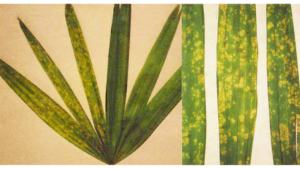Lady palm (Rhapis excelsa) belongs to the family Arecaceae other plants of this family are Dwarf date palm plants. It is not only a beautiful plant that adds up to the aesthetic sense but also in many cultures, it is believed that this plant brings good luck. This plant helps in adding grace and elegance to any setting and is a very popular outdoor gardening plant. This plant also works well as an indoor plant if raised in a loving home it can grow up to 6 feet in indoor conditions.
The leaves of this plant are fan-shaped and dark green with a glossy appearance and numerous leaflets radiating out like the fingers of your widespread hand.
Taking care of Lady Palm
Light and position
During the active growing season, the lady palm needs medium or indirect light, and best to keep the plant in a south or west window position. Not too much direct sunlight is tolerable by this plant.
Temperature range
65 to 75° during the daytime and 10° F less during the nighttime is the optimum temperature for the lady palm plant. Make sure that keep the plant away from cold breezes and hot air.
Watering
Water when the top layer of the soil dries up during the summer.
Humidity
Lady palm plant enjoys a moist and humid environment which can be created by standing the plant on a tray of pebbles covered with water. Also can spray several times a week to maintain the humidity.
Soil or Potting medium
Soil with a good drainage system is essential for the lady palm plant. also incorporate organic fertilizers and mycorrhizal fungi.
Repotting
The plant Lady Palm stays comfortable for years in the same pot. Repotting can be done every after 3 years when the plant is fully grown and there is no space for the roots.
Lady palm diseases
Now let us discuss the main issues which are generally lady palm plants generally face in their life. Hence following are the detail description of some of the lady palm diseases.
1. Leaf spot fungus

Symptoms
Light green necrotic spots are usually circular and small in size initially (0.5 mm) in diameter. These spots enlarge later and grow up to 0.8 mm in diameter parallel to the vein. These fungi are not lethal that is do not kill the leaf fully but yes damage the leaf and spread to the major areas indicating the general health of the plant is not good.
These necrotic spots continue to be light green and eventually turn dark brown to reddish brown. Further pinprick size black or brown fungal fruiting bodies also developed in these spots which gives this mosaic pattern.
Causes
These symptoms are caused by one of several different fungal pathogens like Pseudocercospora rhapisicola, Phytophthora species, and Cercospora rhapisicola.
Studies suggested that high humidity is the main reason for this type of fungal infection in lady palm plants. Older lesions have the spores of this fungus. When we spray water these spores rapidly spread from older leaves to the new leaves.
Control
Strict sanitization and environmental modifications are the only way to control the spreading of this infection. The following steps should be followed to control this disease
- Remove the affected leaves.
- Rake up and dispose of the fallen leaves at the end of the season.
- Spray less water or control the humidity if you see the symptoms.
2. Scale insects

Another issue that a ladypalm can have is the infestation of scale insects. These are a small sap-sucking pest that attacks the foliage. These insects are hidden under their waxy shells or scales that they secret over their bodies. Only newborn insects crawl to find a suitable place to sit otherwise older insects are mostly immobile. The color of these insects is usually brown to greyish-white.
Control
These are easily removed with your thumbnail. Tgus can be picked by hand or can spray insecticidal soap or horticultural oil to eradicate the scale insects.
3. Brown leaf tip

This is also one of the common issues that happens in the lady palm plant. here the tips dried off and turned brown.
Causes
A major cause is the lack of humidity or insufficient water. If the condition worsens then the leaf edges also start turning brown and die.
Control
The control is very simple that is maintain the humidity by misting and placing the plant on a tray filled with water for proper humidity. Check the soil of the plant and whenever the top soil dries off just irrigate the plant. can keep the humidifier in the room or cut off the hot air source or inlet.
Reference
2. Pests and Diseases By: Pippa Greenwood and Andrew Halstead.
